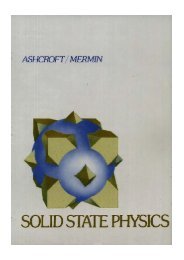[Masao_Doi]_Soft_Matter_Physics
Create successful ePaper yourself
Turn your PDF publications into a flip-book with our unique Google optimized e-Paper software.
1.5 What is common in soft matter? 5<br />
Nematic liquid crystals are extensively used in display devices since<br />
their optical properties are easily controlled by an electric field. The<br />
changes in the optical properties of liquid crystals are also used as<br />
sensors. Strong fibres (used in bullet-proof jackets) are made from liquid<br />
crystalline polymers since polymer chains are strongly oriented in liquid<br />
crystals.<br />
1.5 What is common in soft matter?<br />
As we have seen, soft matter includes a large class of materials. 1 Anatural<br />
question is then what is common in these materials, and why are<br />
they discussed in the framework of ‘soft matter’.<br />
What is common in the above materials is that they all consist of<br />
structural units that are much larger than atoms. Polymer molecules<br />
typically consist of millions of atoms. Colloidal particles of diameter<br />
0.1[µm] involve billions of atoms. Molecules constituting surfactants and<br />
liquid crystals are not very large (including only tens or hundreds of<br />
atoms), but they form ordered structures and move together in a large<br />
unit: surfactant molecules form micelles which move as a collective entity,<br />
and liquid crystalline molecules move together when they rotate.<br />
The fact that soft matter consists of large molecules or assemblies<br />
of molecules which move collectively gives two characteristics to soft<br />
matter:<br />
1 The materials discussed here do not<br />
cover the whole class of soft matter.<br />
Other materials, such as granular materials<br />
and glassy materials, are often<br />
included in soft matter, but will not be<br />
discussed in this book.<br />
(a) Large and nonlinear response. <strong>Soft</strong> matter shows a large response<br />
to weak forces. Polymer molecules consisting of tens of thousands of<br />
atoms are easily deformed, and this gives the softness of rubbers and<br />
gels. Colloidal particles form a very soft solid, which is used in cosmetics<br />
and paints. The optical properties of liquid crystals are easily<br />
changed by an electric field as we have seen. Such large responses<br />
cannot be described by linear relations between the force and the<br />
response. For example, rubbers can be elongated by several hundred<br />
percent of their initial length and their mechanical responses cannot<br />
be described by a linear relation between the stress and strain. The<br />
nonlinear response is quite important in soft matter.<br />
(b) Slow and non-equilibrium response. The collectivity of soft matter<br />
slows down their dynamics. The response time of simple liquids is<br />
of the order of 10 −9 [s], while it can be billions or more times longer<br />
(1 [s] to 10 4 [s]) in solutions of polymers and colloids. Consequently,<br />
the properties of the non-equilibrium state, or the dynamics in the<br />
non-equilibrium state, are quite important in soft matter.<br />
These characteristics are the results of the fact that the fundamental<br />
structural units of soft matter are very large. The reason can<br />
be understood by the following examples.<br />
Consider a tube containing a solution in which the density of solute<br />
is slightly larger than that of solvent. If the tube is rotated as shown in


![[Masao_Doi]_Soft_Matter_Physics](https://img.yumpu.com/56397446/34/500x640/masao-doi-soft-matter-physics.jpg)

